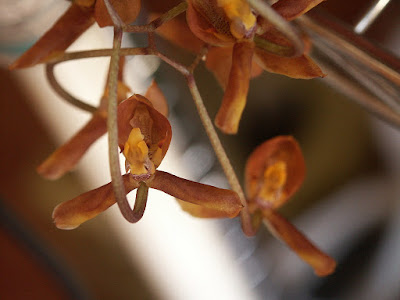Gongora galeata occurs endemically in southern Mexico. It grows usually on mountain slopes directed to the Gulf of Mexico, in the states of Hidalgo, Veracruz, Puebla, Oaxaca and Chiapas...
Gongora galeata also called as The Helmut Gongora, Acropera atropurpurea, Acropera citrina, Acropera flavida, Acropera fuscata, Acropera loddigesii, Acropera luteola, Acropera luteola, Acropera pallida, Acropera purpurea, Acropera sulphurea, Gongora fuscata, Maxillaria galeata, is a species of the genus Gongora. This species was described by Heinrich Gustav Reichenbach in 1854.
IDENTIFY GONGORA GALEATA
Gongora galeata occurs endemically in southern Mexico. It grows usually on mountain slopes directed to the Gulf of Mexico, in the states of Hidalgo, Veracruz, Puebla, Oaxaca and Chiapas. It is also found in the state of Chiapas, on the slopes from the Pacific side. It grows epiphytically in mountainous rainforests, at heights of 600-1800 m, but sometimes also as a rock or terrestrial plant.
It is a medium sized, epiphytic, rarely lithophytic or terrestrial species, warm to cool growing epiphyte, which reaching up to a height of 37 cm, with ovoid-pyriform, longitudinally sulcate, 4-7 cm in height pseudobulbs with 2 apical, plicate, petiolate, elliptic, acuminate, 16-32 cm long and 4 cm wide leaves.
The Helmut Gongora blooms in the summer and fall with basal, 15 to 20 cm long, pendant, many flowered, racemose inflorescence arising on mature pseudobulbs and having a short to long-lived, fragrant flower with a fragrance akin to oranges. The flowers are 4-5 cm wide and are arranged on an inflorescence in 3 rows. They are usually fawn-yellow, and the rod may have red or purple stripes and dots. Each floral shoot forms a semicircle, which causes the yellow-brown, inverted, tubular lip to be above the prone and dorsal leaf.
GONGORA GALEATA CARE AND CULTURE
Cultural information should only be used as a guide, and should be to be adapted to suit you. Your physical location; where you grow your plants, how much time you have to devote to their care, and many other factors, will need to be taken into account. Only then can you decide on the cultural methods that best suit you and your plants.
Light:
Temperature:
It is a plant with moderate thermal requirements. In summer the average day temperature is 24 ° C, night 16-17 ° C, with a daily amplitude of 7 ° C. The average winter temperature is 18-19 ° C, at night 12-13 ° C, with a daily difference of 6 ° C.
Humidity:
The Helmut Gongora needs the humidity of about 80% throughout the year.
Substrate, growing media and repotting:
Due to bent, growing inflorescences, Gongora galeata should be mounted on cork pads or planted in hanging baskets filled with any loose substrate with good drainage. Repotting can be done at any time as soon as new roots grow.
Watering:
From late spring to autumn, for 6-7 months, rainfall is moderate to heavy. Then their number decreases and a dry season follows, lasting 2-3 months at the end of winter and at the beginning of spring. The plants in cultivation should be abundantly watered during active growth, with only slight drying between waterings. In the autumn, watering should be gradually reduced.
Fertilizer:
The plants should be fertilized every week 1/4-1/2 of the recommended dose of fertilizer for orchids. A fertilizer with a high nitrogen content is beneficial from spring to mid-summer, and a fertilizer richer in phosphorus should be used in late summer and autumn.
Rest period:
In the winter, you needs to let the Gongora galeata dry a bit between subsequent waterings, but do not allow them to dry up completely or remain dry for a long period of time. In most cases, light watering is enough every 3-4 weeks. The amount of water should be increased if the pseudobulbs get too wrinkled. Fertilization should be limited or abandoned completely until spring, when stronger watering resumes.

















COMMENTS